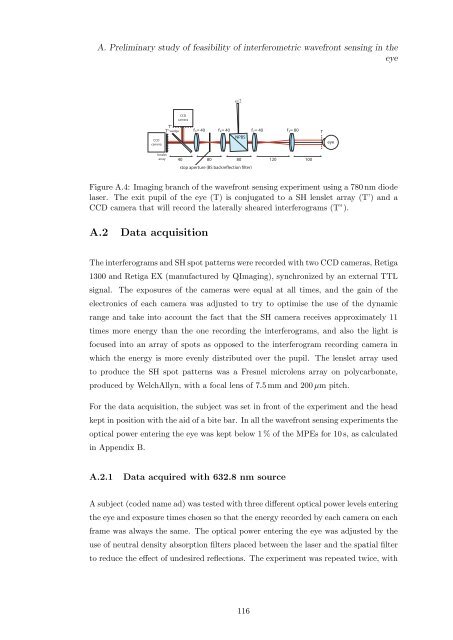Alfredo Dubra's PhD thesis - Imperial College London
Alfredo Dubra's PhD thesis - Imperial College London
Alfredo Dubra's PhD thesis - Imperial College London
You also want an ePaper? Increase the reach of your titles
YUMPU automatically turns print PDFs into web optimized ePapers that Google loves.
A. Preliminary study of feasibility of interferometric wavefront sensing in the<br />
eye<br />
a/2<br />
CCD<br />
camera<br />
CCD<br />
camera<br />
T'' T''<br />
wedge<br />
f 5= 40 f 4= 40<br />
NPBS<br />
f 2= 40<br />
f 3= 80<br />
T<br />
eye<br />
lenslet<br />
array<br />
40<br />
80<br />
80<br />
stop aperture (BS backreflection filter)<br />
120 100<br />
Figure A.4: Imaging branch of the wavefront sensing experiment using a 780 nm diode<br />
laser. The exit pupil of the eye (T) is conjugated to a SH lenslet array (T’) and a<br />
CCD camera that will record the laterally sheared interferograms (T”).<br />
A.2 Data acquisition<br />
The interferograms and SH spot patterns were recorded with two CCD cameras, Retiga<br />
1300 and Retiga EX (manufactured by QImaging), synchronized by an external TTL<br />
signal. The exposures of the cameras were equal at all times, and the gain of the<br />
electronics of each camera was adjusted to try to optimise the use of the dynamic<br />
range and take into account the fact that the SH camera receives approximately 11<br />
times more energy than the one recording the interferograms, and also the light is<br />
focused into an array of spots as opposed to the interferogram recording camera in<br />
which the energy is more evenly distributed over the pupil. The lenslet array used<br />
to produce the SH spot patterns was a Fresnel microlens array on polycarbonate,<br />
produced by WelchAllyn, with a focal lens of 7.5 mm and 200 µm pitch.<br />
For the data acquisition, the subject was set in front of the experiment and the head<br />
kept in position with the aid of a bite bar. In all the wavefront sensing experiments the<br />
optical power entering the eye was kept below 1 % of the MPEs for 10 s, as calculated<br />
in Appendix B.<br />
A.2.1<br />
Data acquired with 632.8 nm source<br />
A subject (coded name ad) was tested with three different optical power levels entering<br />
the eye and exposure times chosen so that the energy recorded by each camera on each<br />
frame was always the same. The optical power entering the eye was adjusted by the<br />
use of neutral density absorption filters placed between the laser and the spatial filter<br />
to reduce the effect of undesired reflections. The experiment was repeated twice, with<br />
116

















